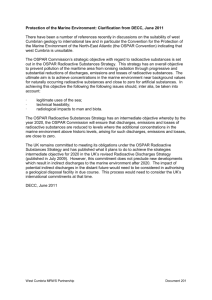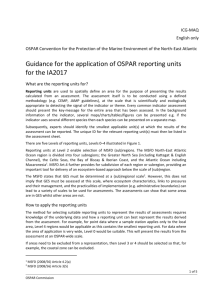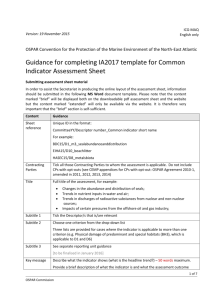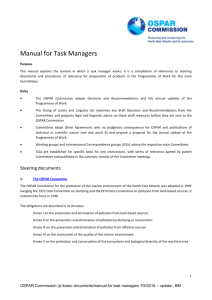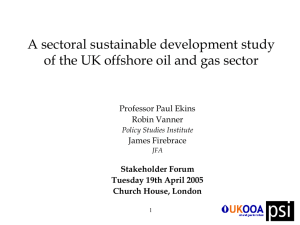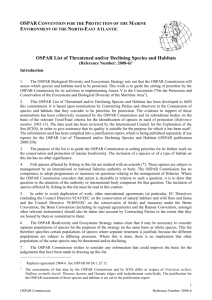OSPAR C P M
advertisement
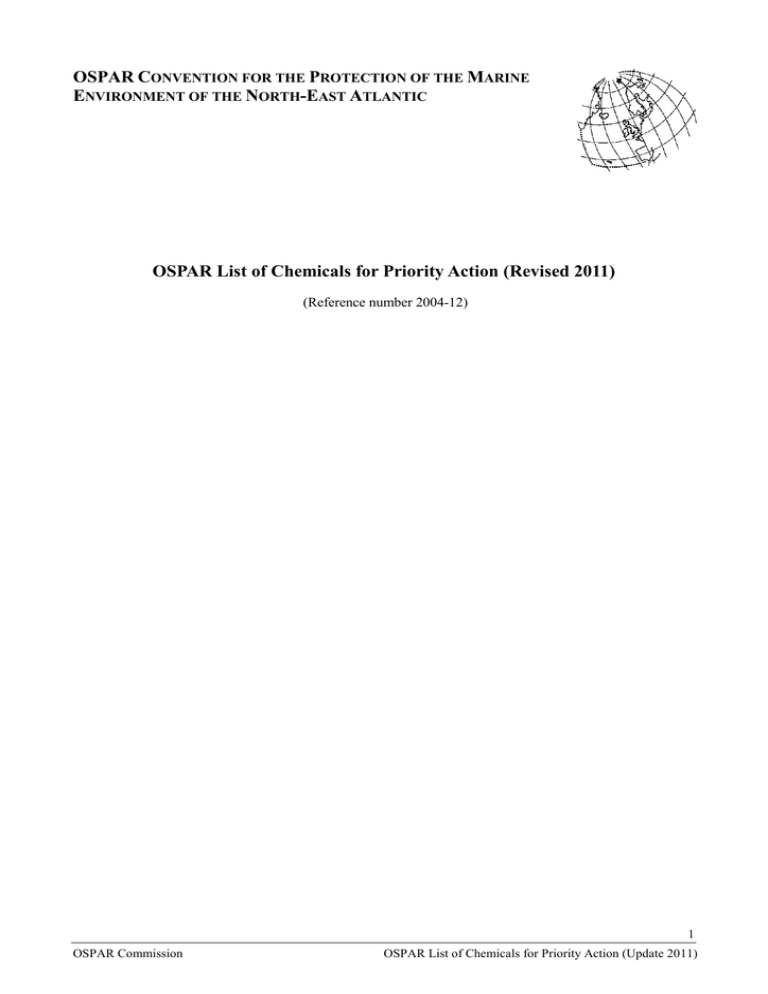
OSPAR CONVENTION FOR THE PROTECTION OF THE MARINE ENVIRONMENT OF THE NORTH-EAST ATLANTIC OSPAR List of Chemicals for Priority Action (Revised 2011) (Reference number 2004-12) 1 OSPAR Commission OSPAR List of Chemicals for Priority Action (Update 2011) CAS No Group of substances / substances Function Last revision of Background document (Lead country) Review statement on Background document A: CHEMICALS WHERE A BACKGROUND DOCUMENT HAS BEEN OR IS BEING PREPARED1 Aromatic hydrocarbon Metallic compound Metal/organometallic compounds cadmium lead and organic lead compounds 2004 (Spain) 2009 (Norway) 2010 2004 (UK) 2011 (The Netherlands) 2009 Organometallic compounds Organic ester Organohalogens 2011 (UK) 2006 (UK) mercury and organic mercury compounds 51000-52-3 1763-23-1 79-94-7 87-61-6 120-82-1 108-70-3 organic tin compounds neodecanoic acid, ethenyl ester perfluorooctanyl sulphonic acid and its salts (PFOS) tetrabromobisphenol A (TBBP-A) 1,2,3-trichlorobenzene 1,2,4-trichlorobenzene 1,3,5-trichlorobenzene brominated flame retardants 2011 (UK) 2005 (Belgium & Luxembourg) 2005 (Belgium & Luxembourg) 2005 (Belgium & Luxembourg) 2009 (Sweden) 2004 (Germany & Belgium) 793-24-8 polychlorinated biphenyls (PCBs) polychlorinated dibenzodioxins (PCDDs) polychlorinated dibenzofurans (PCDFs) short chained chlorinated paraffins (SCCP) 4-(dimethylbutylamino)diphenylamin (6PPD) 2011 2010 2010 2010 2008 2007 (Denmark & Belgium) Organic nitrogen compound 2009 (Sweden) 2006 (Germany) 1 OSPAR 2005 agreed to remove 4-tert-butyltoluene (CAS no 98-51-1), hexachlorocyclopentadiene (HCCP) (CAS No 77-47-4) and triphenylphosphine (CAS No 603-35-0) from the list since they are not PBT substances (see OSPAR 2005 Summary Record, OSPAR 05/21/1 paragraph 7.5). OSPAR 2007 agreed to deselect hexamethyldisiloxane (HMDS) (CAS No 107-46-0) from the List of Chemicals for Priority action since it is not a PBT substance (see OSPAR 2007 Summary Record, OSPAR 07/24/1 paragraph 8.3). The reasons for deselection are set out in the Agreement 2004-13 available on the OSPAR website. 2 OSPAR Commission OSPAR List of Chemicals for Priority Action (Update 2011) 115-32-2 115-29-7 72-43-5 1582-09-8 23593-75-1 732-26-3 140-66-9 dicofol endosulfan hexachlorocyclohexane isomers (HCH) methoxychlor pentachlorophenol (PCP) trifluralin clotrimazole 2,4,6-tri-tert-butylphenol nonylphenol/ethoxylates (NP/NPEs) and related substances octylphenol certain phthalates: dibutylphthalate (DBP), diethylhexylphthalate (DEHP) polyaromatic hydrocarbons (PAHs) musk xylene CAS No § Group of substances / substances Organophosphate Pesticides/Biocides/ Organohalogens 2004 (Finland) 2004 (Germany) 2004 (Germany) 2004 (Finland) 2004 (Finland) 2005 (Germany) 2005 (France) 2006 (UK) 2009 (Sweden) 2008 2008 2008 2008 2006 (UK) 2006 (Denmark & France) 2009 Phthalate esters Polycyclic aromatic compounds Synthetic musk 2009 (Norway) 2004 (Switzerland) Pharmaceutical Phenols 2012 2009 Identified at † Function B:CHEMICALS WHERE NO BACKGROUND DOCUMENT IS BEING PREPARED BECAUSE THEY ARE INTERMEDIATES IN CLOSED SYSTEMS ‡ 4904-61-4 294-62-2 1,5,9 cyclododecatriene‡ cyclododecane‡ Aliphatic hydrocarbons CAS No Group of substances / substances Function OSPAR 2002 OSPAR 2002 Identified at † C: CHEMICALS WHERE NO BACKGROUND DOCUMENT IS BEING PREPARED BECAUSE THERE IS NO CURRENT PRODUCTION OR USE INTEREST* 59447-55-1 36065-30-2 85-22-3 28680-45-7 2440-02-0 1825-21 -4 2-propenoic acid, (pentabromo)methyl ester 2,4,6-bromophenyl 1-2(2,3-dibromo-2methylpropyl) * pentabromoethylbenzene* heptachloronorbornene* pentachloroanisole* Organohalogens OSPAR 2003 OSPAR 2001 OSPAR 2001 OSPAR 2001 OSPAR 2001 3 OSPAR Commission OSPAR List of Chemicals for Priority Action (Update 2011) CAS No Group of substances / substances †† 1321-65-9 1335-88-2 1321-64-8 1335-87-1 32241-08-0 2234-13-1 70776-03-3 55525-54-7 2104-64-5 70124-77-5 465-73-6 2227-13-6 512-04-9 polychlorinated naphthalenes*, trichloronaphthalene* tetrachloronaphthalene* pentachloronaphthalene* hexachloronaphthalene* heptachloronaphthalene* octachloronaphthalene* naphthalene, chloro derivs. * 3,3'-(ureylenedimethylene)bis(3,5,5trimethylcyclohexyl) diisocyanate* ethyl O-(p-nitrophenyl) phenyl phosphonothionate (EPN)* flucythrinate* isodrin* tetrasul* diosgenin* Identified at † Type Organohalogens (cont.) OSPAR 2001 OSPAR 2001 OSPAR 2002 OSPAR 2001 OSPAR 2001 OSPAR 2001 OSPAR 2002 Organic nitrogen compound Pesticides/Biocides OSPAR 2001 OSPAR 2001 OSPAR 2001 OSPAR 2001 OSPAR 2001 Pharmaceutical OSPAR 2001 4 OSPAR Commission OSPAR List of Chemicals for Priority Action (Update 2011) Endnotes † ‡ * The substances in this list were identified at the following OSPAR Commission meetings: OSPAR/MMC 1998: Agreement reference number 1998-16 (Annex 2 to the OSPAR Strategy with regard to Hazardous Substances); (Note: When identifying the substances or groups of substances, OSPAR/MMC 1998 has not allocated CAS and EINECS registration numbers. Background documents adopted by the OSPAR Commission for these substances or groups of substances may indicate which substances have been addressed so far by OSPAR) OSPAR 2000: Agreement reference number 2000-10; OSPAR 2001: Agreement reference number 2001-2; OSPAR 2002: Agreement reference number 2002-18; OSPAR 2003: Agreement reference number 2003-19. The identification of these substances and the consequent action required is explained in § 7.6 of the OSPAR 2002 Summary Record. In brief, these substances have rankings in terms of persistency, liability to bioaccumulate and toxicity which are of equal concern as the other substances on this list. However, to the best of OSPAR’s knowledge, on the basis of information from industry, OSPAR accepts that this substance is produced and used exclusively as an intermediate in closed systems in the production of other substances, under conditions where the safeguards applying are sufficient to avoid reasonable concerns that discharges, emissions or losses of the substance could reach the marine environment. Therefore, every five years, commencing in 2003, Contracting Parties and, where appropriate, observers representing the chemicals industries should report to OSPAR: a. whether they have found any evidence that these chemicals are being produced, used or discharged without being subjected to safeguards to avoid reasonable concerns that discharges, emissions or losses of the substances could reach the marine environment, and, if so, what that evidence is, and what action (if any) has been taken; b. whether there have been any cases where applications have been made for approvals involving these chemicals, and, if so, what decision was taken. The identification of these substances and the consequent action required is explained in § 4.13 of the OSPAR 2001 Summary Record. In brief, these substances have rankings in terms of persistency, liability to bioaccumulate and toxicity which are of equal concern as the other substances on this list. However, to the best of OSPAR’s knowledge, there is no current production or use in the OSPAR states. Therefore, commencing in 2003 and every five years thereafter, or earlier, if information becomes available, Contracting Parties and, where appropriate, observers representing the chemicals industries should report to OSPAR: a. whether they have found any evidence that these chemicals are being produced, used or discharged, and, if so, what that evidence is, and what action (if any) has been taken; b. whether there have been any cases where applications have been made for approvals involving these chemicals, and, if so, what decision was taken. †† Polychlorinated naphthalenes should be treated as a group of substances (OSPAR 02/21/1, § 7.7). PFOS is the highly persistent and toxic breakdown product of a number of perfluorooctanyl sulphonyl compounds. Several PFOS precursors have been selected on the OSPAR List of Substances of Possible Concern. The background document will identify these precursors and, if necessary, appropriate control measures will be proposed. CAS and EINECS numbers refer only to the acid form of PFOS. § The following substances belonging to the group of polyaromatic hydrocarbons have been deselected from the OSPAR List of Substances of Possible Concern on the grounds that they do not meet the cut-off values for persistence in the Selection Criteria used in the Initial Selection Procedure adopted by OSPAR 2001 (Reference Number: 2001-1) and are therefore not considered to be a priority for action by OSPAR: naphthalene, 2-methyl(CAS No. 91576); 1-phenanthrenecarboxylic acid, 1,2,3,4,4a,4b,5,6,10,10a-decahydro-1,4a-dimethyl-7-(1methylethyl)-, methyl ester, [1R-(1.alpha.,4a.beta.,4b.alpha.,10a.alpha.)]- (CAS No. 127253); 1phenanthrenemethanol, 1,2,3,4,4a,4b,5,6,7,9,10,10a-dodecahydro-1,4a-dimethyl-7-(1-methylethyl)- (CAS No. 127366); 7H-dibenzo[c,g]carbazole (CAS No. 194592); 13H-dibenzo[a,i]carbazole (CAS No. 239645); 1H-3a,7methanoazulene, 2,3,4,7,8,8a-hexahydro-3,6,8,8-tetramethyl-, [3R-(3alpha,3abeta,7beta,8aalpha)]- (CAS No. 469614); 1-phenanthrenemethanol, 1,2,3,4,4a,4b,5,6,10,10a-decahydro-1,4a-dimethyl-7-(1-methylethyl)-, [1R(1.alpha.,4a.beta.,4b.alpha.,10a.alpha.)]- (CAS No. 666842); cedrene- (CAS No. 11028425); 1phenanthrenemethanol, tetradecahydro-1,4a-dimethyl-7-(1-methylethyl)- (CAS No. 13393936); 1phenanthrenecarboxylic acid, tetradecahydro-1,4a-dimethyl-7-(1-methylethyl)-, methyl ester, [1R(1alpha,4abeta,4balpha (CAS No. 19941287). 5 OSPAR Commission OSPAR List of Chemicals for Priority Action (Update 2011) The following substance belonging to the group of organic tin compounds has been deselected from the OSPAR List of Substances of Possible Concern on the grounds that it does not meet the cut-off value for persistence in the Selection Criteria used in the Initial Selection Procedure adopted by OSPAR 2001 (Reference Number: 20011) and is therefore not considered to be a priority for action by OSPAR: stannane, tributyl(1-oxododecyl)oxy(CAS No. 3090366). The following substance belonging to the group of polychlorinated biphenyls has been deselected from the OSPAR List of Substances of Possible Concern on the grounds that it does not meet the cut-off value for persistence in the Selection Criteria used in the Initial Selection Procedure adopted by OSPAR 2001 (Reference Number: 2001-1) and is therefore not considered to be a priority for action by OSPAR: 1,1'-biphenyl, 4,4'dichloro- (CAS No. 2050682). OSPAR 2006 agreed to deselect the following substances belonging to the group of certain phthalates: "DIDP (1,2-Benzenedicarboxylic acid,di-C9-11-branched alkyl esters, C10-rich (CAS N° 68515-49-1)), DIDP (di“isodecyl”phthalate (CAS N° 26761-40-0)), DINP (1,2-Benzenedicarboxylic acid, di-C8-10-branched alkyl esters, C9-rich (CAS N° 68515-48-0)) and DINP (di-“isononyl” phthalate (CAS N° 28553-12-0)). They are not PBT substances for the reasons set out in the Agreement 2004-13 available on the OSPAR website (see OSPAR 2006 Summary Record, OSPAR 06/23/1 paragraph 8.3). 6 OSPAR Commission OSPAR List of Chemicals for Priority Action (Update 2011)
